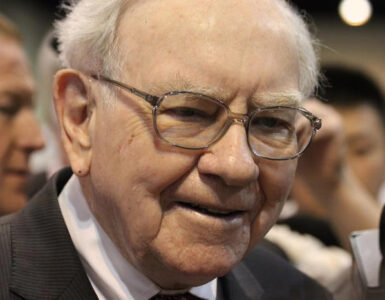The holiday season is underway, but a few key earnings and economic reports will deck the halls on Wall Street before markets shut down for a long Christmas weekend.
In the days ahead, the economic calendar will bring investors the latest personal consumption expenditures price index — or PCE — which is the Fed’s preferred inflation measure, as well as another reading on GDP, a batch of housing data, and the Conference Board’s gauge of consumer confidence.
On the corporate side, earnings from Nike (NKE), FedEx (FDX), Micron Technology (MU), Carnival (CCL) will keep traders busy.
The earnings and economic lineup will offer 2022’s final clues for investors’ main focus heading into the new year: how much higher Federal Reserve officials will raise interest rates and whether those policy moves will tip the U.S. economy into a recession.
The PCE price index — the Fed’s preferred measure of inflation set for release Friday — is perhaps the most crucial data point of the week ahead.
On a monthly basis, PCE is expected to show a 0.1% rise in November, down slightly from 0.3% the prior month, Bloomberg consensus estimates show. PCE inflation likely eased to a rate of 5.5% from 6% previously over the year. Core PCE, stripping the volatile food and energy components out, is set to show a 0.2% climb over the prior month — unchanged from October — and a slightly slower rise of 4.7% over the year, down from 5% the prior month.
Following the Fed’s final policy announcement of 2022 on Wednesday, strategists pointed out that the most surprising datapoint among economic projections from policymakers was an upward revision to their core PCE expectations to 3.5% from 3.1% previously at the end of 2023.
“This was somewhat surprising to us because we thought a higher path for the policy rate would mean a lower path for inflation, but these revisions suggest that the median member sees inflation as being significantly stickier than they previously thought in September,” Bank of America’s Michael Gapen and his team of strategists said in a recent note.
Nikko Asset Management Chief Global Strategist John Vail also pointed out that this means officials think they will need to keep rates at a high terminal rate through 2023, even assuming some lag effects.
Worries about “higher for longer” rates and a resulting economic downturn have so far weighed heavily on Wall Street this December, a traditionally bullish period for the stock market that appears to be anything but this season.
Investors have been hoping for a Santa Claus rally — a sustained rise in the stock market that occurs around year-end holidays. Typically defined as covering the last five trading days of the year and first two of the new year, regardless of dates this year’s hopes for a rally have been dampened.
On Friday, U.S. stocks confirmed back-to-back weekly losses for the first time since September. For the week, the S&P 500 shed 2.1%, the Dow Jones Industrial Average 1.7%, and the technology-heavy Nasdaq Composite 2.7%.
During the post-meeting press conference, Fed Chair Jerome Powell emphatically asserted he and his colleagues are committed to bringing inflation back down to 2%, the U.S. central bank’s long-term price stability target as measured by PCE.
The last reading in October came in three times that goal at 6%, with the core measure at 5%. Meanwhile, the Consumer Price Index (CPI) rose at an annual clip of 7.1% in November. The CPI index sources data from consumers, while PCE sources from businesses, each tracking a different scope of expenditures. CPI, for example, only captures out-of-pocket consumer medical expenses, while PCE includes employer contributions.
Updates on the housing market will also be closely watched in the week ahead. The December homebuilder survey and measure of housing starts, existing home sales, and new home sales are all on tap. Shelter cost increases are a key component of sticky inflation.
Elsewhere on the economic docket, the government will release its third and final estimate of GDP, the broadest measure of U.S. economic activity, which is likely to show real gross domestic product increased at an annual rate of 2.9 percent in the third quarter of 2022 — unchanged from prior estimates. The Conference Board’s Consumer Confidence Index, which tracks U.S. consumer attitudes, spending plans, and expectations for inflation, stock prices, and interest rates, is also due out.
On the corporate side, FedEx and Nike earnings will be critical gauges of consumer spending during the all-important holiday shopping season, while Micron’s results will offer the latest look at the chip industry.
—
Economic Calendar
Monday: NAHB Housing Market Index, December (34 expected, 33 during prior month)
Tuesday: Housing Starts, November (1.400 million expected, 1.425 during prior month); Building Permits, November (1.480 million expected, 1.526 million during prior month, downwardly revised to 1.512 million); Housing Starts, month-over-month, November (-1.8% expected, -4.2% during prior month); Building Permits, month-over-month, November (-2.1% expected, -2.4% during prior month)
Wednesday: MBA Mortgage Applications, week ended Dec. 16 (-3.2% during prior week); Current Account Balance, Q3 (-$223.5 billion expected, -$251.1 billion during prior month); Existing Home Sales, November (4.20 million expected, 4.43 million during prior month); Existing Home Sales, month-over-month, November (-5.2% expected, -5.9% during prior month); Conference Board Consumer Confidence, December (101.0 expected, 100.2 during prior month); Conference Board Present Situation, November (137.4 during prior month); Conference Board Expectations, November (75.4 during prior month)
Thursday: Chicago Fed National Activity Index, November (-0.05 during prior month); GDP Annualized, quarter-over-quarter, Q3 Third Estimate (2.9% expected, 2.9% prior); Personal Consumption, quarter-over-quarter, Q3 Third Estimate (1.7% expected, 1.7% prior); GDP Price Index, quarter-over-quarter, Q3 Third Estimate (4.3% expected, 4.3% prior); Core PCE, quarter-over-quarter, Q3 Third Estimate (4.6% expected, 4.6% prior); Initial Jobless Claims, week ended Dec.17 (222,000 expected, 211,000 during prior week); Continuing Claims, week ended Dec. 10 (1.685 expected, 1.671 million during prior week); Leading Index, November (-0.5% expected, -0.8% during prior month); Kansas City Manufacturing Index, October (-2 expected, 1 during prior week)
Friday: Personal Income, month-over-month, November (0.3% expected, 0.7% during prior month); Personal Spending, month-over-month, November (0.2% expected, 0.8% during prior month); Real Personal Spending, month-over-month, November (0.0% expected, 0.5% during prior month); PCE Deflator, month-over-month, November (0.1% expected, 0.3% during prior month); PCE Deflator, year-over-year, November (5.5% expected, 6.0% during prior month); PCE Core Deflator, month-over-month, November (0.2% expected, 0.2% during prior month); PCE Core Deflator, year-over-year, November (4.7% expected, 5.0% during prior month); Durable Goods Orders, November Preliminary (-1.0% expected, 1.1% during prior month); Durables Excluding Transportation, November Preliminary (0.0% expected, 0.5% during prior month); Non-Defense Capital Goods Orders Excluding Aircraft, November Preliminary (0.2% expected, 0.6% during prior month); Non-Defense Capital Goods Shipments Excluding Aircraft, November Preliminary (-0.2% expected, 1.5% during prior month); University of Michigan Consumer Sentiment, December final (59.1 expected, 59.1 prior); New Home Sales, November (600,000 expected, 632,000 during prior month); New Home Sales, month-over-month, November (-5.1% expected, 7.5% during prior month)
Source: Yahoo Finance










